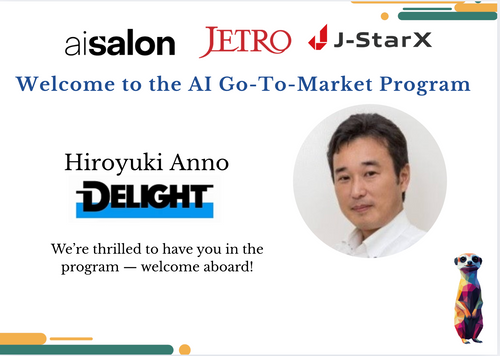From Idea-Stage or MVP Founder to Global Startup Founder
— A Non-Native Founder’s Practical Guide
Introduction
This article is written from the perspective of a non-native English speaker.
I’m 54 years old, a serial entrepreneur, and currently the founder of a B2B AI startup.
We’re at the pre-seed stage, building toward a $1M fundraising goal, with a U.S. headquarters and subsidiaries in Japan and Singapore.
This post summarizes what I’ve learned about how professionals with ideas or MVPs can transition from employees to global startup founders.
If it serves as a small compass for your own journey, I’ll be glad.
1. Startup vs. Traditional Business: The Core Difference
| Traditional / SME | Startup | |
|---|---|---|
| Product focus | Multiple products | Single core product |
| Growth pace | ~10% annually | 10%+ monthly |
| Cost structure | High variable costs | <15% (software-based) |
| Business model | Contract / consulting | Product-led growth |
| Goal | Stability | Scale |
A common misconception is that any new business is a startup.
But if the business model depends on custom projects or consulting revenue, it’s not a startup.
A true startup builds a scalable product that can grow exponentially — not a service that grows linearly with headcount.
2. From Employee to Founder: Understand Your Stage
Founding a company and focusing only on getting funding is not the right approach.
Even if you raise money, it doesn’t mean you’ll become a successful founder.
Each stage has specific milestones.
- 📘 See the Founder Institute Startup Stages
- 📊 Explore Industry Benchmarks
Understanding where you are — idea, MVP, early revenue, or traction stage — helps you choose the right next step and avoid premature fundraising or scaling.
3. Choosing Your HQ and Market Strategy
If You Aim for Global SaaS: U.S. Delaware C-Corp
For B2B SaaS or software startups targeting the global market,
a U.S. (Delaware) headquarters is the only realistic option for raising VC capital.
Once a VC joins your cap table, restructuring to Delaware later becomes nearly impossible.
If you’re still pre-VC, do the Delaware Flip early.
🔗 What is the Delaware Flip? — Skala Blog
If You Target Asia: Singapore HQ
Singapore is ideal for founders targeting Southeast Asia — an English-speaking environment with transparent regulation and global-friendly banking and tax systems.
Experience articles:
- Selected and Invited to the Singapore Fintech Festival
- Must-Know Information for Founders Relocating to Singapore
- Aspire Ignite — Our Singapore Journey
- What Japanese Founders Can Learn from Southeast Asian VCs
If You Target Europe: Estonia E-Residency
For Europe, start lean with an Estonian e-Residency company — then expand to another EU country once you gain traction.
Experience article:
4. Which Program Should You Join First?
(a) For Employees with an Idea or Founder with MVP: Founder Institute (FI)
What you’ll gain:
- A global startup mindset
- Confidence in English pitching and storytelling
- Structured guidance from global mentors
Pros:
- You can participate remotely while keeping your job
- Supportive global community with local leaders
Cons:
- Requires 20–30 hours per week of output
- Intense, like a “startup treadmill” — but worth the challenge
Experience articles:
- My Founder Institute Japan Experience
- What Is the Founder Institute? A Graduate’s Perspective
- Post-Program Growth & Funding Lab
Notable graduate example: Udemy
2010: Seed $1M → 2021: NASDAQ IPO (Market Cap $2.2B, Revenue $700M+)
TechCrunch 2010
(b) For B2B SaaS Founders: Y Combinator (YC)
🔗 https://www.ycombinator.com/apply/
If you’re post-MVP and gaining early traction, YC is your best next step.
Don’t wait until you “feel ready” — apply early.
Recommended videos:
(c) For SME-Focused SaaS: 500 Global
🔗 https://500.co/founders/flagship
I joined their Japan Program (SVE), not the flagship accelerator — but it was one of the most practical and growth-driven programs I’ve attended.
Experience article: Learning and Growth at 500 Global Tokyo Accelerator
(d) For Hardware / Manufacturing Startups: Alchemist Accelerator
🔗 https://www.alchemistaccelerator.com/
(e) For Life Science Startups: UC Berkeley SkyDeck
🔗 https://skydeck.berkeley.edu/
5. How Many Accelerators Should You Join?
Accelerators are designed to help your business grow, not just to collect certificates.
You’ll certainly gain valuable connections and new insights — but remember, each program costs dozens or even hundreds of hours of focus that could otherwise go into building your product.
It’s a trade-off between learning and execution.
I personally classify accelerators into two categories:
- Bootcamp-type accelerators: usually include investment and only accept founders.
- Business-matching accelerators: focus on exhibitions, pitch contests, or partnerships; usually open to executives as well, and often do not involve investment.
For bootcamp-type accelerators, one high-quality, globally recognized program in your lifetime is enough — ideally at a key growth phase of your startup.
However, if you later hit a wall at a different stage of growth, it’s reasonable to join another bootcamp tailored to that phase.
Repeating the same type of accelerator in the same phase may expand your network, but it often reduces real growth opportunities.
On the other hand, for business-matching accelerators, there’s no limit.
Governments and major corporations around the world regularly organize short-term accelerator or pitch programs (often with travel support or prize funding) to attract promising startups for collaboration.
Participating in these multiple times is not only acceptable but also highly beneficial for expanding your business partnerships.
6. Final Thoughts: Anyone Can Become a Global Founder
- You can start part-time while keeping your job.
- Focus on building a scalable product, not just an idea.
- Join international programs early to build your global mindset and network.
“Silicon Valley is not a place, but a mindset.”
— LinkedIn Founder, Reid Hoffman
Entrepreneurship isn’t a career — it’s a learning process.
Each small step brings you closer to the world.





























